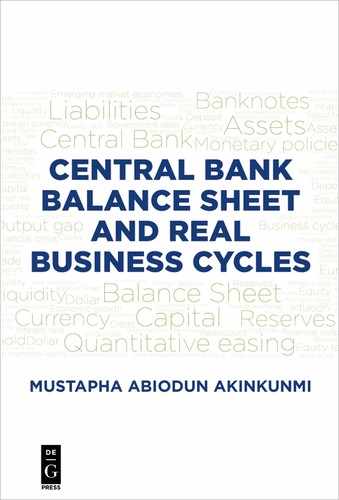Contents
Chapter 1: Global Genesis of the Central Bank
Chapter 2: Relevance of the Central Bank Balance Sheet
2.1Understanding Relevance of Central Bank Balance Sheet in Functions of Economy
2.1.1Similarities and Differences between a Company’s Balance Sheet and a Central Bank Balance Sheet
2.2Trajectory Relevance of the Central Bank Balance Sheet
2.3Externality of the Central Bank Balance Sheet Size
Chapter 3: Components of Central Bank Balance Sheets
3.1Factors Influence the Reporting Frequency of Central Bank Balance Sheets
3.2Components of Central Bank Assets and their Composition Analysis
3.3Components of Central Bank Liabilities and their Composition Analysis
Chapter 4: Analytical Framework of Central Bank Balance Sheets
4.1Structure of Central Bank Balance Sheets
4.2.1Computation of Indicators
4.2.2Significance of these Indicators
4.2.3Underlying Assumptions of Four Indicators
4.3Determinants of Central Bank Balance Sheet Composition
4.4Classification of Central Bank Balance Sheet Components
4.5Theoretical Landscape: Quantity Theory of Money versus Quality Theory of Money
Chapter 5: Evolution of Central Bank Balance Sheets and Their Heterogeneous Dimensions
5.1What Makes Central Bank Balance Sheets Special?
5.2Historic Uses of Central Bank Balance Sheets
5.3Composition of Central Bank Balance Sheet Liabilities
5.3.1Central Bank Liabilities in Normal Times
5.3.2Snapshot of Selected Economies’ Performance before the 2007–2008 Crisis
5.3.3Country-by-Country Snapshots of Economic Structure Since 2005
5.3.4A Look at the Balance Sheets: 2005 and 2006
5.3.5Snapshot of Selected Economies’ Performance during the 2007–2008 Crisis
5.3.6Snapshot of Selected Economies’ Performance Today
5.3.7Central Bank Liabilities Today
Chapter 6: Composition of Central Bank Balance Sheet Assets
6.1Central Bank Assets in Normal Times
6.1.1Central Bank Assets of Emerging Economies
6.2Central Bank Assets During the 2007–2008 Crisis
6.2.1Central Bank Assets of Developing and Emerging Economies during the 2007–2008 Crisis
6.3.1Central Bank Assets of Emerging Economies Today
6.4Asset-Side Composition and Economic Growth Nexus
6.4.1Asset-Growth Nexus before the 2007–2008 Crisis
6.4.2Asset-Growth Nexus during the 2007–2008 Crisis
6.4.3Asset-Growth Nexus after the 2007–2008 Crisis
6.5The Evolution of Central Bank Balance Sheets in the Future
Chapter 7: Financial Ratios of the Central Bank Balance Sheet
7.4Liquidity Ratios I, II, and III
Chapter 8: Central Bank Operations
8.1Types of Central Bank Operations
8.2Central Bank Policy Instruments
8.2.4Money Market Investor Funding Facility
8.2.6Commercial Paper Funding Facility
8.2.7Primary Dealer Credit Facility
8.2.8Recap of Policy Instruments
Chapter 9: Real Business Cycles
9.1.3Fluctuations in the Business Cycle
9.2Concept of RBCs Applied to Economic Policy
9.3Techniques of Estimating RBCs
9.4Methods to Estimate Potential Output and Output Gaps
9.4.2Univariate Filters Method
9.4.4Production Function Approaches
9.4.5Criteria for Evaluating Different Methods of Estimating Potential Output
Chapter 10: Central Bank Balance Sheets and Real Business Cycles
10.1Linkages between Central Bank Balance Sheets and Real Business Cycles
10.1.1Monetary Policies and Business Cycles
10.1.2Identifying an Acceptable Range of Values
10.2Impact Evaluation of Central Bank Balance Sheets on Economic Environment
10.2.1Central Bank Balance Sheets and Debt Management
10.2.2Modeling Challenges Confronting Central Bank Balance Sheets
Questions Left Unanswered: Areas for Future Research
Appendix I: Central Bank Balance Sheets of Different Countries
Malaysia’s Central Bank Balance Sheets for the Month of February 2018
Monetary Authority of Singapore
Nigeria’s Central Bank Balance Sheets for the Month of November 2017
